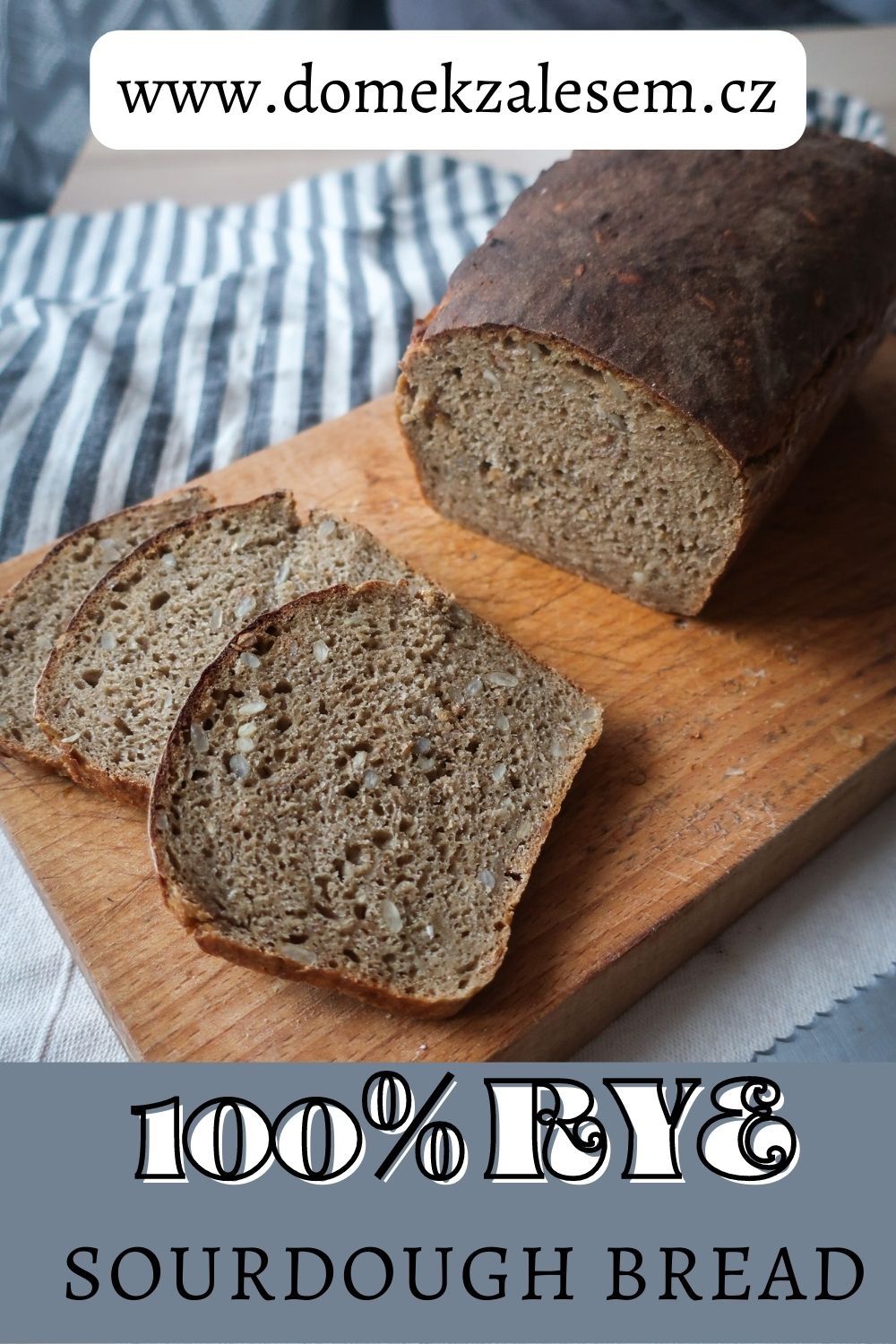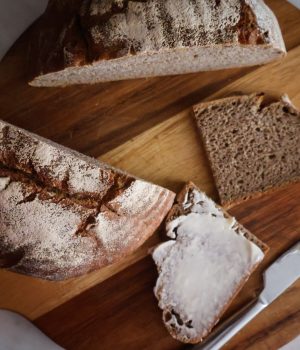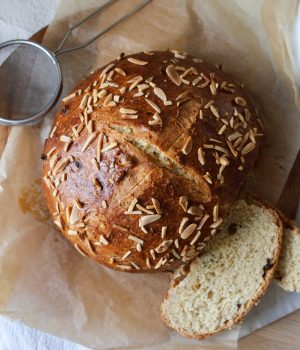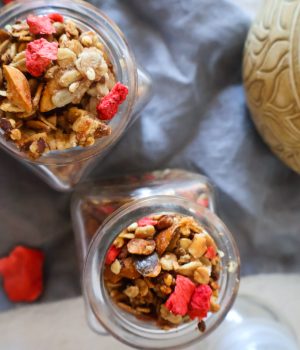If you've been thinking about how to get your life back on track after Christmas, maybe this rye sourdough bread will be helpful! It's a healthy, flavorful, delicious, light 100% rye bread, that's so tasty fresh or lightly toasted in days after.
By light bread, I mean it's not gummy, like rye breads usually are. Thanks to the sourdough starter, the bread has a slightly sour taste and the fermentation process also improves the nutritional profile of the already very healthy rye flour. Fermentation process ensures better digestibility of the flour and better absorption of the nutrients and minerals contained in rye.

Is rye sourdough bread actually healthy?
Yes, this is one of the healthiest breads you can bake or buy. Rye flour is a great source of fiber, vitamins and minerals. Compared to wheat flour, rye flour is also considered to be more filling and contains less gluten. Plus, when you bake bread at home, you have the benefit of knowing the exact ingredients that goes into bread. For example, you can keep an eye on the amount of salt or sweetener added and enrich the bread with seeds, which add healthy fats, among other things! All you have to try different type of breads and you will quickly find out that some keep you full for a long time and some don't.
Is it difficult to bake bread with rye flour?
Rye flour acts very differently from wheat flour. It doesn't contain much gluten, so the dough doesn't have as much elasticity and doesn't form large air holes. Even so, you can still make soft and "fluffy" bread. Rye flour sucks water differently and the key is to use just enough water to keep the dough as dry as possible. If you increase the water any further, you risk making the dough gummy, tough or sticky.
Properly mixed rye bread dough looks a bit like concrete and even behaves like concrete when the unbaked dough dries. That's why I recommend washing the dishes immediately! Rye dough must not be overworked and should be baked in a bread tin as it is harder to work with. The dough also doesn't tend to rise much, which is again due to the lower amount of gluten in the flour.
Are you interested in baking sourdough bread?
Try my other favorite recipes!

What can I add more to the rye sourdough bread?
Rye sourdough bread is delicious on its own. As always, flour, water, sourdough starter and salt are used in the dough. I strongly recommend adding a teaspoon of honey or molasses, which can also give the dough a nice color. But you can also add many other ingredients to improve the texture, taste and nutritional profile of rye sourdough bread.
These are my TOP favorite ingredients:
- Spices - try premixed bread blends or single spices like coriander, cumin and fennel. Spices are great ground finely or coarsely in bread!
- Seeds - sunflower, pumpkin or crushed flax seeds are excellent. They add healthy beneficial fats to the bread.
- Oats and cereal - Rye flakes are the perfect choice for this 100% rye bread. However, classic oats, wheat or spelt flakes will work well too
As for added ingredients, I recommend adding them very carefully. In particular, different seeds or flakes suck up different amounts of water and could result in high or low hydration in the dough.

How to bake rye sourdough bread?
As with all sourdough bread recipes, you need to start the bread the day before. And this by preparing the levain. In the evening, mix 75 g of rye wholemeal flour (or bread flour), 75 g of water and 1 tbsp (25 g) of sourdough starter in a large bowl. Mix the ingredients into a thicker dough and leave in a warm place overnight for 8-12 hours to ferment.
In the morning, add 150 g of wholemeal or bread rye flour, 150 g of water, 11 g of salt, 1 tsp (10 g) of honey or molasses, 50 g of sunflower seeds and 20 g of rye flakes. Mix the dough with a wooden spoon just until you can no longer see the dry spots. The dough is very thick and it is very important not to overwork the dough by stirring. Cover the bowl with the dough with a plastic bag and leave in a warm place for 2- 3 hours to ferment.

After this time, the dough will slightly rise. Add another 190 g of rye bread flour and 130-150 g of water. Stir again with a spoon to make sure there are no dry spots in the dough. Prepare a bread tin measuring 8x18x8 cm. Grease it with oil (I use coconut oil) and line it with baking paper. Let the baking paper peek over the edge, so it's easier to remove the bread from the tin. Transfer the dough in batches to the tin and smooth the surface with a spatula dipped in water. I always pour water into the bowl I used for the dough and dip the spatula as needed. Let the dough rise again. This can take varying amounts of time (about 3-6 hours). The dough should rise at least 1 cm, ideally 2 cm. Then bake in a preheated oven at 200°C for about 45 minutes.

After baking, remove the bread from the tin and wrap it in a wet tea towel. Simply place the towel under running water for a few seconds and wrinkle it a little to help the water distribute. Let the wrapped bread cool before slicing.
TIPS:
- by wrapping the bread in a wet towel, the crust will not be hard, because it will absorb the extra moisture
- if you forget to wrap the bread in a wet towel and the crust is too hard, it may help to put the cooled bread in a plastic bag overnight to soften the crust
- you can also use coconut syrup, date, maple or dark agave syrup instead of honey
- bread baked in this way will keep well for about a week if stored properly
How to plan baking rye sourdough bread?
- 1. day in the evening: 20:00 mix the levain and let ferment overnight in a hot spot
- 2. day in the morning: 7:00 in a big bowl combine flour, water, salt, honey, seeds, rye flakes and mix the dough, let it rest for 2-3 hours
- around 9:00: add more flour and water, prepare a loaf tin and fill with the dough
- around 13:00 when the dough has risen about 1 cm, bake it in the preheated oven at 200°C for about 45 minutes.
- 13:45 the bread is baked so remove it from the tin, wrap it in a wet towel and put it on a cooling rack
- 16:00 : the bread is cool enough to slice and eat
Video instructions:
Recipe

1 loaf
Rye sourdough bread
Ingredients:
for levain:
- 75 g rye wholemeal flour
- 75 g water at room temperature
- 1 tbsp (25 g) sourdough starter (rye or wheat)
for dough:
- whole levain (or you can add 1 tbsp of levain into a jar for the next baking)
- 150 g + 190 g rye bread flour
- 150 g + 150 g water
- 11 g salt
- 1 tsp (10 g) honey or molasses
- 20 g rye flakes
- 50 g sunflower seeds
others:
- loaf tin 8x18x8 cm
- oil and baking paper
- wire rack
Instructions:
We have to divide the bread making process into two days.
- First day: In a big bowl, mix all ingredients for levain. Let it ferment overnight for 8-12 hours in a warm place.
- Second day: In the morning, add 150 g of wholemeal or bread rye flour, 150 g of water, 11 g of salt, 1 tsp (10 g) of honey or molasses, 50 g of sunflower seeds and 20 g of rye flakes. Mix the dough with a wooden spoon just until you can no longer see the dry spots. The dough is very thick and it is very important not to overwork the dough by stirring.
- Cover the bowl with a plastic bag and leave in a warm place for 2- 3 hours to ferment.
- After this time, the dough will slightly rise. Add another 190 g of rye bread flour and 150 g of water. Stir again with a spoon to make sure there are no dry spots in the dough.
- Prepare a bread tin measuring 8x18x8 cm. Grease it with oil (I use coconut oil) and line it with baking paper. Let the baking paper peek over the edge, so it's easier to remove the bread from the tin.
- Transfer the dough in batches to the tin and smooth the surface with a spatula dipped in water. I always pour water into the bowl I used for the dough and dip the spatula as needed. Let the dough rise again. This can take varying amounts of time (about 3-6 hours). The dough should rise at least 1 cm, ideally 2 cm.
- Then bake in a preheated oven at 200°C for about 45 minutes.
- After baking, remove the bread from the tin and wrap it in a wet tea towel . Simply place the towel under running water for a few seconds and wrinkle it a little to help the water distribute.
- Slice the bread after it has cooled completely.





Dnes jsem poprvé pekla chleba podle vás z čerstvě namleté žitné mouky a musím říct , že lepší chleba jsem nejedlá. Super recept , moc vám za něj děkuji.
Krásný den paní Blaženo, jsem moc ráda, že se vám recept osvědčil. 🙂
Dobrý den,
Žitný chléb podle vás pečeme již několik týdnů a je to zatím nejlepší chleba který jsme si upekli.
Děkuji
Dobrý den,
to je skvělé, že se vám chléb daří. Taky jej doma pečeme pravidelně! 🙂 Moc děkuji za zprávu
Dobrý den milá paní Radko,
již téměř 3/4 roku peču chlebiky
podle vašich receptů. Myslím, že vaše recepty jsou velmi srozumitelné a skvěle se podle nich vše připravuje.
Za mě jste opravdu skvělá a děkuji, že jste mě “ naučila” péct chleba.
Děkuji Petra
Dobrý den Petro, moc děkuji za krásnou zprávu! Jsem moc ráda, že se vám chlebíky daří. 🙂
Dobrý deń, jak dlouho nechavate chleba v natočené utěrce?
Děkuji.
Dobrý den, Nechávám minimálně 2 hodiny nebo než chléb vychladne 🙂
Dobrý vecer, pečetě chléb i v domácí pekárně? Dekuji
Dobrý den, zrovna testuji recepty pro domácí pekárnu. Pro celožitný chléb si ale myslím, že není vhodná už z principu. Žitné těsto se nesmí dlouho propracovávat a také by z něj asi špatně šly vyndat hnětací metly po upečení, protože ještě horké těsto je velmi lepivé. Já mám ale starší model pekárny, tak nevím, co všechno umí ty moderní. 😀 Určitě dejte vědět, pokud budete recept zkoušet.
Dobrý den,
proč se žitné těsto nesmí dlouho propracovávat? (A co to je dlouho?) Co se s ním stane?
Děkuji
Lenka
Dobrý den, žitná mouka obsahuje málo lepku a chová se jinak než pšeničná. Pokud těsto přemícháte, vznikne vám tužší gumovitější střídka. Pokud jen jemně, tzn. jen dokud nezmizí v těstě suchá místečka, tak získáte střídku nadýchanou.
Výborný chleba a máte recepty moc hezky zpracované. Ráda podle Vás peču.
Moc děkuji 🙂
Prosím, mohla bych dostávat podle vás recepty?
Děkuji Fofoňková Olga
Dobrý den, odkud máte prosím formu o rozměrech 8x18x8 cm? Nemohu nikde dohledat, všude mají moc velké. Děkuji moc
Dobrý den, můžete použít i jinou malou formu na chleba. Nemusí to být přímo tyto rozměry.
Dobrý den paní Radko,
Peču podle Vás 100% žitný chléb už více jak půl roku. Je to nejlepší recept, který jsem zkoušela.
Prosím o radu, kde dělám chybu. Je hodně mazlavý, peču z celozrnné žitné mouky Permerka.
Děkuji za odpověď
Helena
Hezký den, jestli je chléb opravdu hodně mazlavý, tak doporučuji prodloužit dobu prvního kynutí. Pomoci by mohlo také přidání něčeho kyselého do těsta (lžičku octa, lžíci jogurtu) podobně jako to dělám ve chlebu Tourte de Seigle https://domekzalesem.cz/cs_cz/2024/07/09/tourte-de-seigle-100-zitny-bochnik/ . V neposlední řadě můžete vyzkoušet změnit značku mouky, já používám Probio. 🙂
Dobrý den, neskutečně dlouho jsme hledala dobrý žitný chléb a konečně ho našla. Je výborný!!!
Jsem moc ráda, že se vám recept líbí 🙂
Dobrý den Radko,
včera poprvé jsem upekla žitný chléb dle Vašeho receptu a postupu. Přiznám se, že se mi nechtělo moc věřit, že by byl k jídlu, protože ten postup byl neuvěřitelně jednoduchý….., ale o to větší bylo mé překvapení, když jsem chléb rozkrojila a ochutnala….
Takže doma mám cca 10 kg pšeničné mouky (pekla jsem jen pšeničné chleby) no a dnes jsem si objednala mouku žitnou, protože ….. no prostě díky Vám.
Moc děkuji, že jste svůj postup zveřejnila a jsem moc ráda, že na mě skrze všechny ty ostatní postupy vykoukl.
Díky.
Vlaďka
Hezký den,
Jsem moc ráda, že se vám recept podařil 🙂 děkuji za krásný povzbuzující komentář 🙂